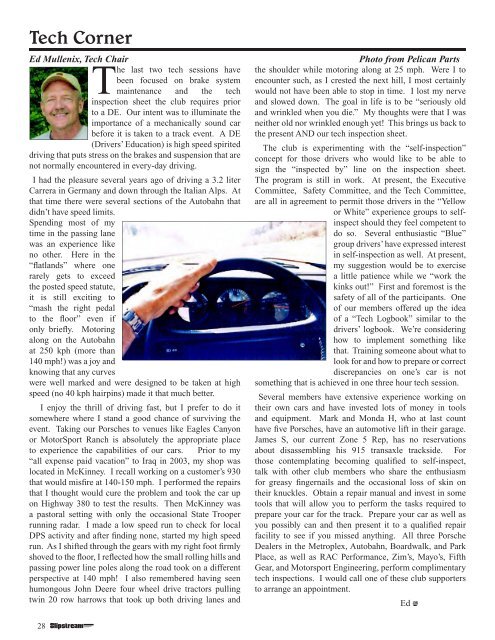Slipstream - April 2011
The monthly newsletter of the Maverick Region of the Porsche Club of America
The monthly newsletter of the Maverick Region of the Porsche Club of America
You also want an ePaper? Increase the reach of your titles
YUMPU automatically turns print PDFs into web optimized ePapers that Google loves.
Tech Corner<br />
Ed Mullenix, Tech Chair<br />
The last two tech sessions have<br />
been focused on brake system<br />
maintenance and the tech<br />
inspection sheet the club requires prior<br />
to a DE. Our intent was to illuminate the<br />
importance of a mechanically sound car<br />
before it is taken to a track event. A DE<br />
(Drivers’ Education) is high speed spirited<br />
driving that puts stress on the brakes and suspension that are<br />
not normally encountered in every-day driving.<br />
I had the pleasure several years ago of driving a 3.2 liter<br />
Carrera in Germany and down through the Italian Alps. At<br />
that time there were several sections of the Autobahn that<br />
didn’t have speed limits.<br />
Spending most of my<br />
time in the passing lane<br />
was an experience like<br />
no other. Here in the<br />
“flatlands” where one<br />
rarely gets to exceed<br />
the posted speed statute,<br />
it is still exciting to<br />
“mash the right pedal<br />
to the floor” even if<br />
only briefly. Motoring<br />
along on the Autobahn<br />
at 250 kph (more than<br />
140 mph!) was a joy and<br />
knowing that any curves<br />
were well marked and were designed to be taken at high<br />
speed (no 40 kph hairpins) made it that much better.<br />
I enjoy the thrill of driving fast, but I prefer to do it<br />
somewhere where I stand a good chance of surviving the<br />
event. Taking our Porsches to venues like Eagles Canyon<br />
or MotorSport Ranch is absolutely the appropriate place<br />
to experience the capabilities of our cars. Prior to my<br />
“all expense paid vacation” to Iraq in 2003, my shop was<br />
located in McKinney. I recall working on a customer’s 930<br />
that would misfire at 140-150 mph. I performed the repairs<br />
that I thought would cure the problem and took the car up<br />
on Highway 380 to test the results. Then McKinney was<br />
a pastoral setting with only the occasional State Trooper<br />
running radar. I made a low speed run to check for local<br />
DPS activity and after finding none, started my high speed<br />
run. As I shifted through the gears with my right foot firmly<br />
shoved to the floor, I reflected how the small rolling hills and<br />
passing power line poles along the road took on a different<br />
perspective at 140 mph! I also remembered having seen<br />
humongous John Deere four wheel drive tractors pulling<br />
twin 20 row harrows that took up both driving lanes and<br />
Photo from Pelican Parts<br />
the shoulder while motoring along at 25 mph. Were I to<br />
encounter such, as I crested the next hill, I most certainly<br />
would not have been able to stop in time. I lost my nerve<br />
and slowed down. The goal in life is to be “seriously old<br />
and wrinkled when you die.” My thoughts were that I was<br />
neither old nor wrinkled enough yet! This brings us back to<br />
the present AND our tech inspection sheet.<br />
The club is experimenting with the “self-inspection”<br />
concept for those drivers who would like to be able to<br />
sign the “inspected by” line on the inspection sheet.<br />
The program is still in work. At present, the Executive<br />
Committee, Safety Committee, and the Tech Committee,<br />
are all in agreement to permit those drivers in the “Yellow<br />
or White” experience groups to selfinspect<br />
should they feel competent to<br />
do so. Several enthusiastic “Blue”<br />
group drivers’ have expressed interest<br />
in self-inspection as well. At present,<br />
my suggestion would be to exercise<br />
a little patience while we “work the<br />
kinks out!” First and foremost is the<br />
safety of all of the participants. One<br />
of our members offered up the idea<br />
of a “Tech Logbook” similar to the<br />
drivers’ logbook. We’re considering<br />
how to implement something like<br />
that. Training someone about what to<br />
look for and how to prepare or correct<br />
discrepancies on one’s car is not<br />
something that is achieved in one three hour tech session.<br />
Several members have extensive experience working on<br />
their own cars and have invested lots of money in tools<br />
and equipment. Mark and Monda H, who at last count<br />
have five Porsches, have an automotive lift in their garage.<br />
James S, our current Zone 5 Rep, has no reservations<br />
about disassembling his 915 transaxle trackside. For<br />
those contemplating becoming qualified to self-inspect,<br />
talk with other club members who share the enthusiasm<br />
for greasy fingernails and the occasional loss of skin on<br />
their knuckles. Obtain a repair manual and invest in some<br />
tools that will allow you to perform the tasks required to<br />
prepare your car for the track. Prepare your car as well as<br />
you possibly can and then present it to a qualified repair<br />
facility to see if you missed anything. All three Porsche<br />
Dealers in the Metroplex, Autobahn, Boardwalk, and Park<br />
Place, as well as RAC Performance, Zim’s, Mayo’s, Fifth<br />
Gear, and Motorsport Engineering, perform complimentary<br />
tech inspections. I would call one of these club supporters<br />
to arrange an appointment.<br />
Ed<br />
28


















